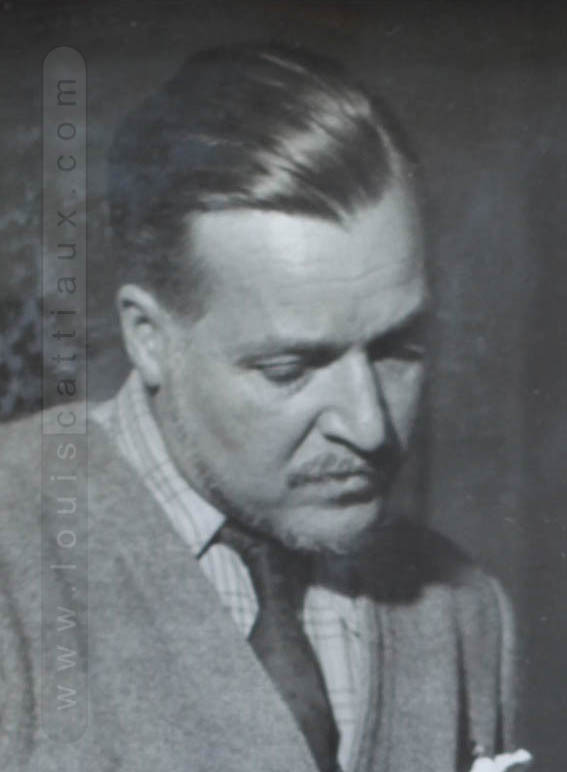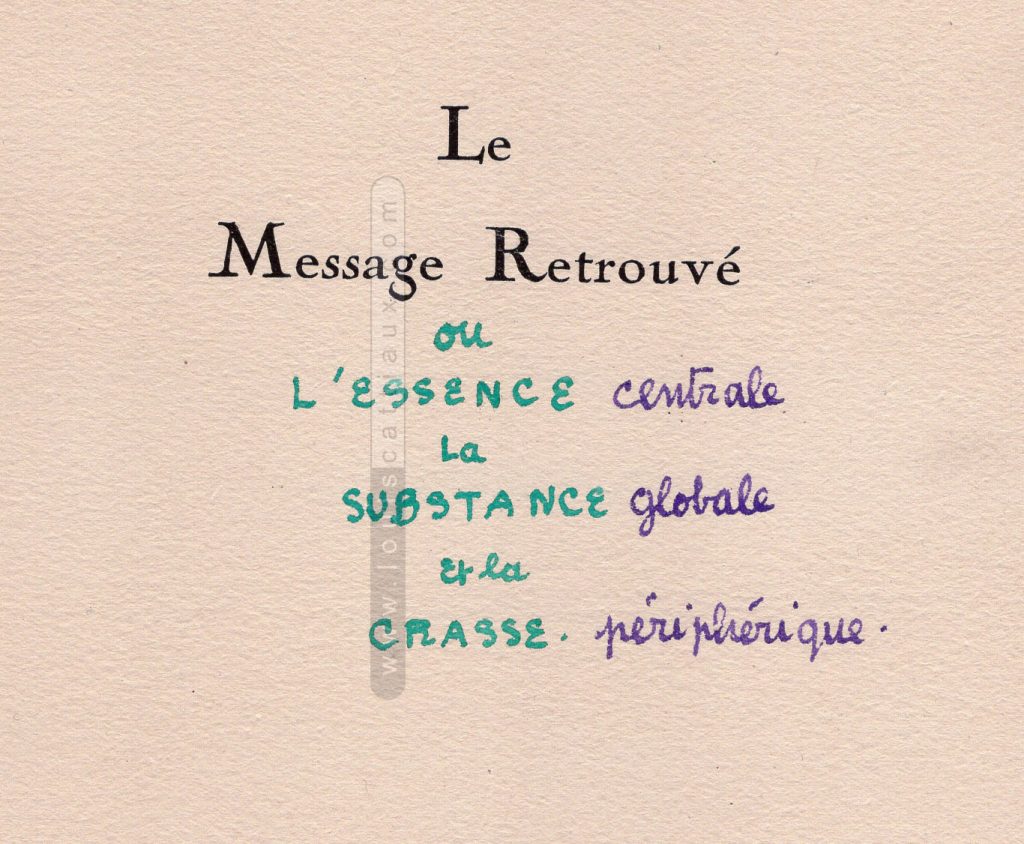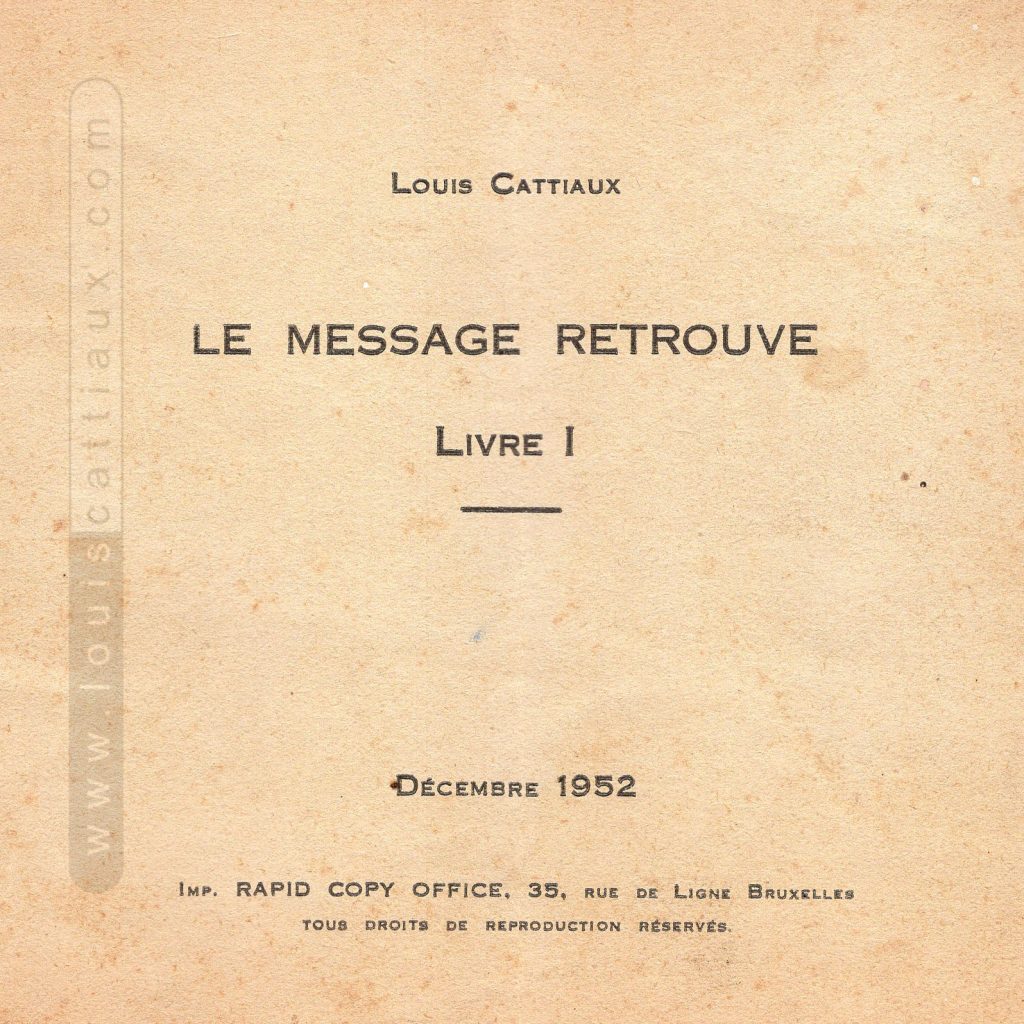Who shall study the Book and travel along the way of the Unique One? He will understand, to his great astonishment, that this Message is addressed to him personally, and that it speaks to his deepest, and undoubtedly also his most ignored, innermost being.
THE WAY OF THE BOOK (2004) by Charles d’Hooghvorst
INTRODUCTORY NOTE by R. Arola
Charles d’Hooghvorst wrote his last article on The Message Rediscovered shortly before leaving this world. Despite its posthumous publication, he had not written this text with the intention of publishing it. Since the passing of his brother Emmanuel, he had taken to recording his thoughts in a large notebook, using one of those blue Bic ballpoint pens that he had always used. Free from any commitment to the outside world, he sought to bring the teachings of Cattiaux closer to those of his brother. He knew that The Message Rediscovered was incomprehensible without a particular hermeneutic, one that he drew from the commentaries Emmanuel had provided for over fifty years.
The last writings of Charles d’Hooghvorst are concise and adorned with quotes that seem unconnected at first glance, but which, upon reflection, appear to be linked in an occult and underlying manner to the mystery that Cattiaux had rediscovered and conveyed in his Message Rediscovered. The book is the man himself, as it is «that secret Place called Book, which is located in the midst of man’s life».
In reality, he echoes his brother’s words when he states:
He who read himself in his midst knew the secret of Scripture». (Cf. E. d’ Hooghvorst, «Aphorismes du Nouveau-Monde » nº 46, in «Le Fil d’ Ariane, Écriture et tradition», cit., 1998-99, nos 63-64, p. 13).
What Cattiaux found and what the d’Hooghvorst brothers recognized is that which lies within every man, locked away, in potential, coiled like a cunning serpent, and which can rise up in purity. In reference to the Saviour, Cattiaux wrote: «What is it that we are not in potential? And what are we that He is not in act?» (MR XXVIII, 3’)
Without a doubt, the way of the Book is the path that the inner God follows when He awakens and grows within man with the help of traveling grace.
If one were to compare this last text to his first article on The Message Rediscovered, dating from 1982, one could observe that, despite the distance travelled, their content does not differ by an iota. In the first, he writes that anyone who reads the book attentively:
[…] will understand, to their great astonishment, that this Message is addressed to them personally, that it speaks to their deepest being, and undoubtedly also the most ignored.
Only the forms have changed: what was initially a discreet invitation becomes, twenty-two years later, a clear affirmation. One could deduce that the author had measured the urgency of making men understand the «message» bequeathed by his friend. From then on, his brother, who had always guided his steps, was no longer there, and he himself was approaching eighty years old. Perhaps, therefore, these words of Cattiaux echoed in his heart:
At present, we shout from the rooftops that which was once whispered in the ear, for all prudence has become useless. Has men’s ignorance with regard to wise and holy things not gone as far as it can? (MR XXV,36)
THE WAY OF THE BOOK (2004) by Charles d’Hooghvorst
For the Holy One, Blessed be He, there is a place called the Book, for it is written: «Seek in the Book of IHVH and read» (Isaiah 34, 16), for all the strength and power of the works of the Holy One, Blessed be He, depend on this Book and emanate from it.
Zohar
Who shall study the Book and who shall travel along the way of the Unique One ? (MR XX, 44)
The Book teaches the Way that leads to the Unique One, that is, to the reunion of what is above and what is below, because what was divided by the mixture of the fall must be reunited to reform the Unique One.
The verse opposite it in the right-hand column seems to show us the way:
Let us free our virginal queen, and she shall give us a son who shall save the human race and restore it in its primary splendour. I.N.R.I. (MR XX,44’)
I.N.R.I. : Igne Natura Renovatur Integra, i.e. «by Fire Nature is Renewed in its Integrity».
It is thus this fire I.N.R.I. which frees our virginal queen from this secret Place called the Book, which is located in the midst of man’s life.
We heard the following comment from Emmanuel d’Hooghvorst:
When man was sent into exile, there was a mysterious, dark place in that exile, called the Black Virgin, where the seed of light was to be found. We must find it again and we must bring forth this light. This is the Great Work.
Is it not this virginal queen that we must free, by means of «this black cloud that wanders lost», the I.N.R.I. fire «that ignites the wick of knowledge»?
Is the black virgin not the first and most mysterious of all mothers? Is it not she whom God has looked at amorously since the beginning? Is it not she who has given birth to the light that illuminates the world? (MRXXVI, 33)
Miriam and Aaron spoke against Moses about the Kushite woman he had taken, because he had taken a Kushite [black] woman. They said, «Did IHVH speak only through Moses? Did he not also speak through us?» And IHVH heard him […] and he said: «Listen to my words carefully: if you have any prophet of IHVH, I reveal myself to him in a vision, I speak to him in a dream. This is not my servant Moses; he is known to be faithful in all my house; I speak to him mouth to mouth, showing myself and not in riddles, and he beholds the face of IHVH. Why then were you not afraid to speak against my servant, against Moses?» (Numbers 12, 1 to 8)
The Message Rediscovered seems to respond to the criticisms made by Moses’ sister:
Do not be ashamed of the black colour that God has chosen for you, for it is in that that all the others are hidden. Do you not know that the light came out of the darkness in the beginning, and that in the end shall rest in the golden splendour? (MRXXVII, 17’)
[…] The Art of Isis will accomplish this miracle by separating through cooking the pure from the impure that prevented this maturation from taking place. In this work, indeed, it is only necessary to cook, but by means of the fire of the Philosophers called I.N.R.I., their unique agent. (E. d’Hooghvorst, Ibidem)
Such is the work of the I.N.R.I. Fire, the work of Creation. This is why the first word in the book of Genesis is Berechit, «in a beginning», which can be read, by swapping the letters, Berit Ech, i.e. «Alliance of Fire». It was this alliance that was made for Jacob, when he battled with the Fire of the Night and defeated it.
Thus, the Adepts call themselves «Philosophers by Fire».
God gave us the Book of nature, but we did not read it ! (MR XXIX, 50)
We all received it at our incarnation in this exiled world, but because of the original fall, we no longer know how to read it.
If he prints for us his way white upon black, shall we notice it, shall we study it and shall we follow it ? […] (MR XXIX, 51’)
I.N.R.I. is a white fire upon a black fire that teaches us how to read the book of Nature, by freeing our virginal queen.
The Philosophers say that fire is the Art with which nature proceeds.
By cabala it appears to us that the Holy Scripture is a dark and caliginous fire on the back of a white and wonderfully resplendent fire; this is the Fire of the Holy Spirit. (B. de Vigenère, Treatise on Fire and Salt, J. Cailloué, Rouen, 1642, p. 21.).
This black fire that gradually consumed the fallen man will be washed and softened by the white fire of celestial Isis. Thus, man learns to read himself again. It is then that, like a dawn, the purity of the earthly Mother appears, Nature regenerated.
He who read himself in his midst knew the secret of Scripture (Cf. E. d’ Hooghvorst, «Aphorismes du Nouveau-Monde » nº 46, in «Le Fil d’ Ariane, Écriture et tradition», cit., 1998-99, nos 63-64, p. 13).
Alchemists would say that one must learn how to read gold, this gold frozen in Pluto’s hell, also called «black gold» or «misread gold»; it must be dissolved to release its germinative virtue, the root of the Philosopher’s Stone. (Cf. E. d’Hooghvorst, Le Fil de Pénélope, cited, vol. I, p. 115. See also E. d’Hooghvorst, “Aphorisms of the New World,” no. 17, in Le Fil d’Ariane, Écriture et tradition, cited, 1998-99, num. 63-64, p. 10: «In letters was placed the gold, in them a genius read the Art.»)
O Almighty Father, teach those whom you deem worthy of entering your Ways, this fire in which all science consists. (Refutation of the anonymous Pantaléon, L. d’Houry, Paris, 1689, p. 84.).
The Poet who cooks his sweet Mercury
in wise wood, has read by this juice,
the cross of I.N.R.I., a cherished salt
by his chosen ones. Without reading
this I.N.R.I., what is the cross?
It dreams alone in the silent night,
and the lost man, without a lead,
dreams of atoning there.
E. d’Hooghvorst (Cf. Ibidem)



